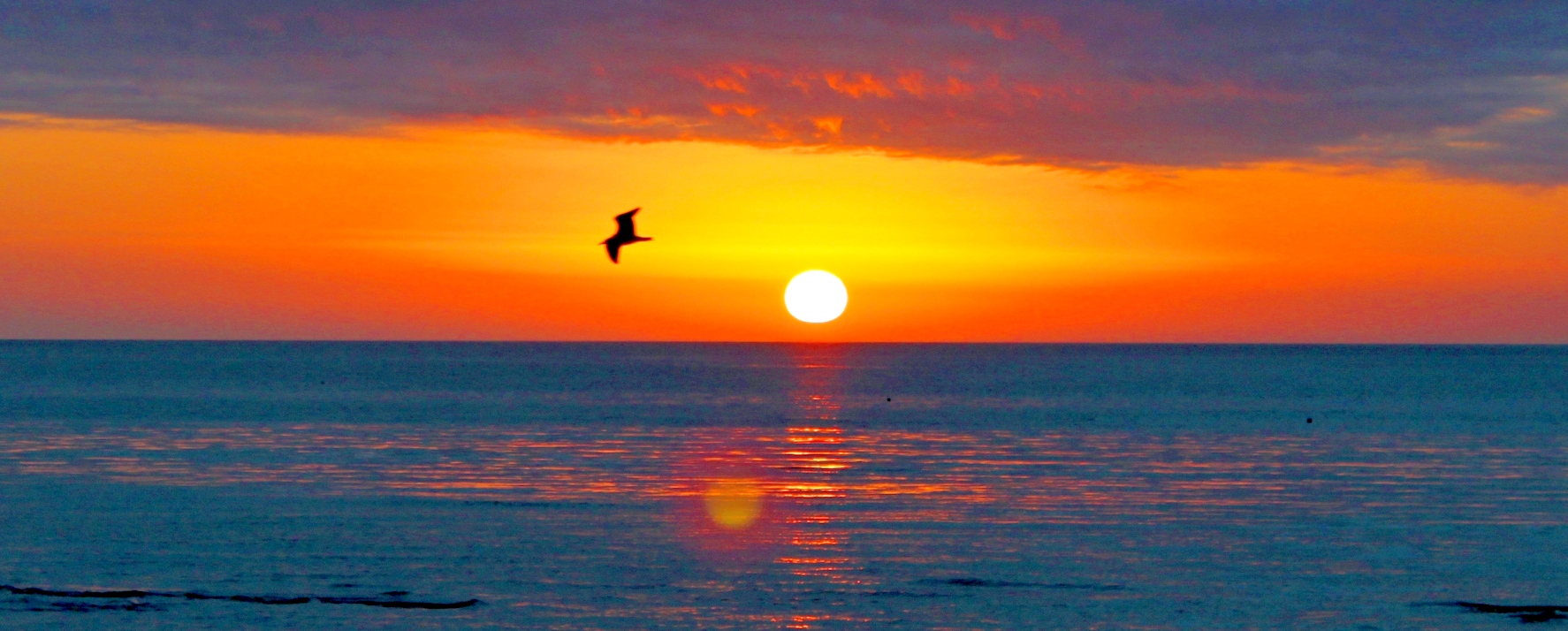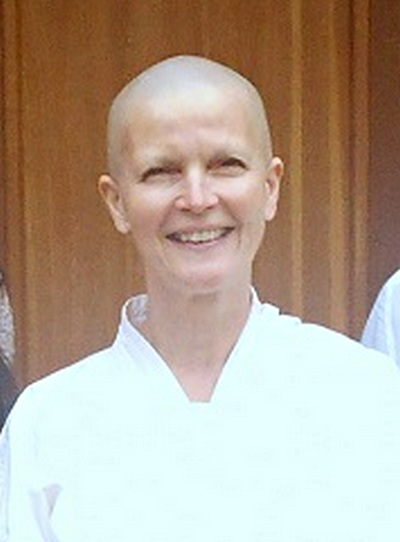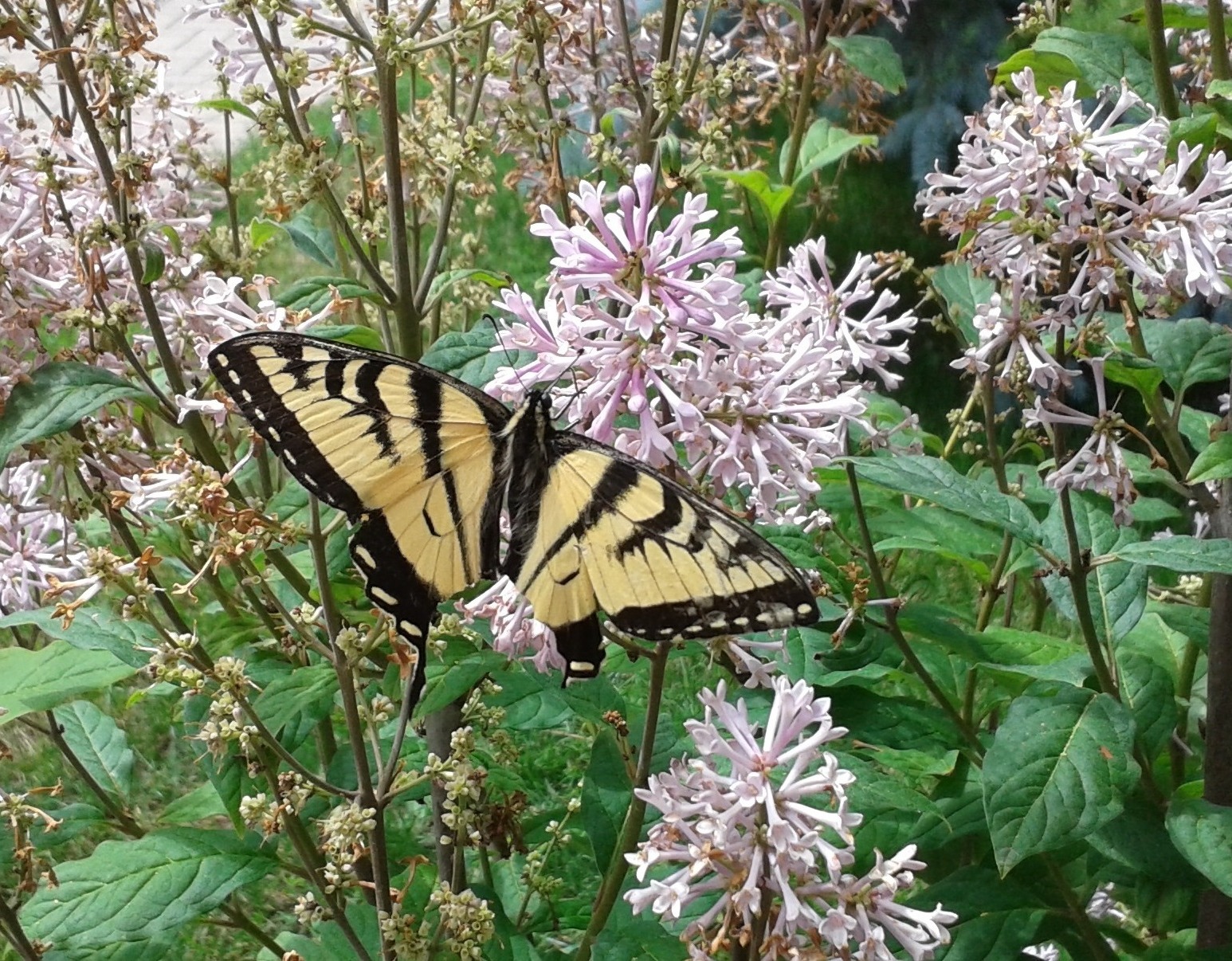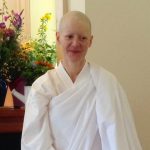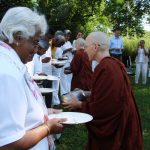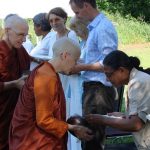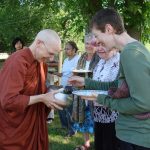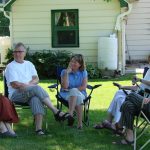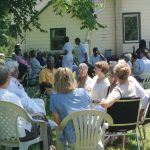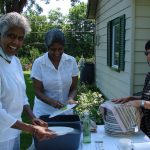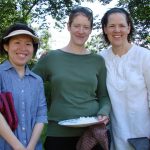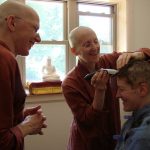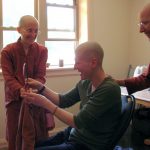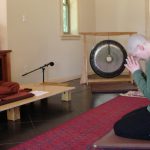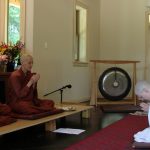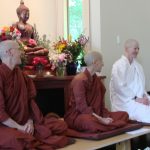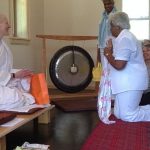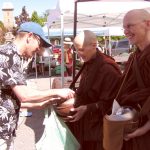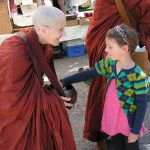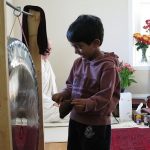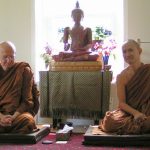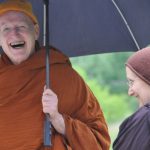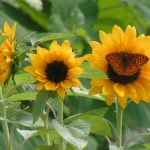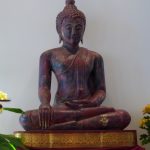Buddhist Women on a Path of Spiritual Awakening
A Samaneri in September
“Although it is difficult to cross over the storm-swept sea of passion,
those who live in accord with the well-taught Dhamma reach the other shore.”
With great happiness, we would like to share with you the news of a samaneri ordination.
On Sunday, September 13th, our dear Anagarika Acala will take life vows as a ten-precept nun (samaneri). We warmly welcome you to join us for this special day in her life as well as for our nuns’ community at Sati Saraniya Hermitage.
Anagarika Acala is from the UK and has been training with us for more than a year. She has quickly gained the respect and admiration of all who have come to know her and has become a treasured member of our community. With her decision to take the samaneri training, she will deepen her commitment to the Path of Awakening by renouncing money and living as an alms-mendicant, wholly reliant on the kindness of the lay community for her requisites.
Please join us to witness this beautiful ceremony and, through your presence, encourage Acala at this pivotal moment on her journey. If you are unable to attend, please send your blessings from afar.
September 13, 2015 at Sati Saraniya Hermitage:
* 10:30 am Rice pindapat
* 11:00 am Pot-luck alms-giving meal
* 1:30 pm Ordination ceremony
Friendship with the Lovely
Continuing on the theme of noble friendship, in the Upaddha Sutta, Half of the Holy Life, Samyutta Nikāya, 45.2, we read as follows:
“Thus have I heard. On one occasion, the Blessed One was dwelling among the Sakyans in the town of Nāgaraka. Then the Venerable Ānanda went to see the Blessed One. Having approached the Blessed One, he paid homage to the Blessed One, sat down to one side, and said to him:”
“Venerable sir, this is half of the holy life, that is, good friendship, good companionship, good comradeship.”
“Not so, Ānanda! Not so, Ānanda! This is the whole of the holy life, Ānanda, that is, good friendship, good companionship, good comradeship. When a monk has a good friend, a good companion, a good comrade, it is to be expected that he will develop and cultivate the Noble Eightfold Path…”
“And how does a monk who has a good friend, a good companion, a good comrade, develop and cultivate the Noble Eightfold Path? Here, Ānanda, he develops right view based on seclusion, dispassion, and cessation, maturing in release. He develops right intention… right speech… right action… right livelihood… right effort… right mindfulness… right concentration, which is based upon seclusion, dispassion, and cessation, maturing in release. It is in this way, Ānanda, that a monk who has a good friend, a good companion, a good comrade, develops and cultivates the Noble Eightfold Path.”
“By the following method too, Ānanda, it may be understood how the whole of the holy life is good friendship, good companionship, good comradeship: by relying upon me as a good friend, Ānanda, beings subject to birth are freed from birth; beings subject to aging are freed from aging; beings subject to death are freed from death; beings subject to sorrow, lamentation, pain, grief, and despair are freed from sorrow, lamentation, pain, grief, and despair. By this method, Ānanda, it may be understood how the whole of the holy life is good friendship, good companionship, good comradeship.
More than two and a half millenia after the Blessed One, we find ourselves – contemporary Theravāda Buddhist nuns – somewhat isolated here in rural Lanark County, Ontario from other ordained women of this tradition.
This year, however, we feel blessed to meet and associate with good friends in the holy life – sisters in the robe committed to the teachings and the fulfillment of the Eightfold Noble Path. In early May, Ayya Santacitta Bhikkhuni, co-abbess of Aloka Vihara in California, came for a brief visit.
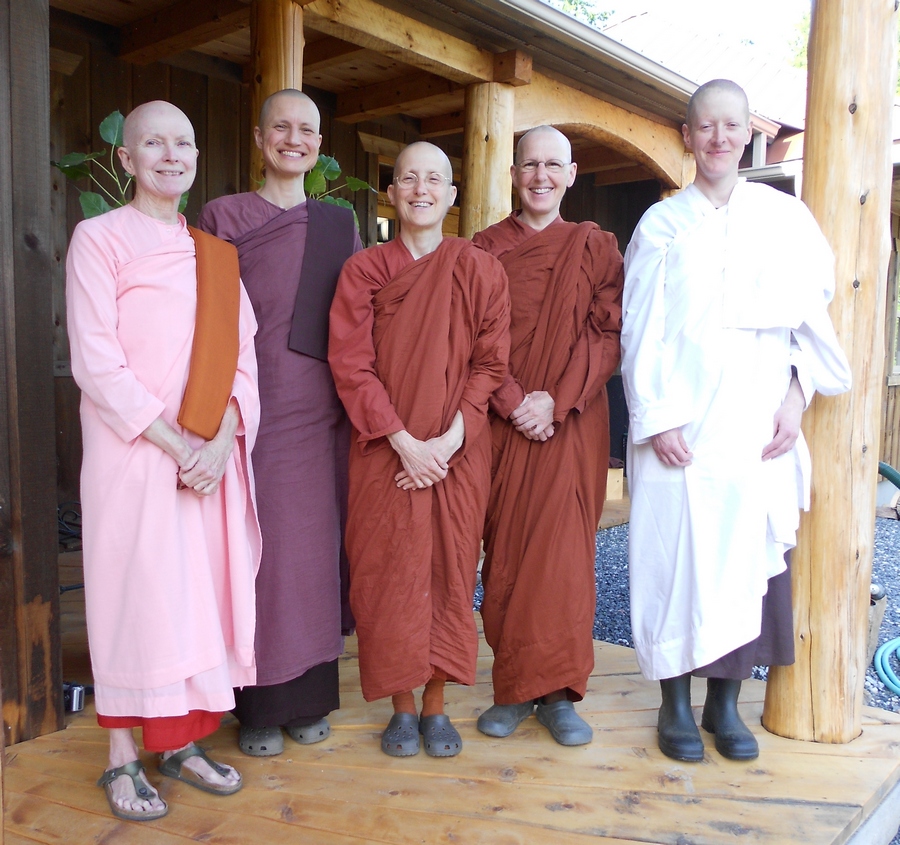 Soon, two more nuns joined us for a longer stay. Pictured above with our resident community are Sayalays Kusalanandi, a 10 precept nun from Germany training with Pa-Auk Sayadaw of Myanmar, and Khemanandi, an American 8 precept nun ordained by Sayadaw U Tejaniya of Myanmar.
Soon, two more nuns joined us for a longer stay. Pictured above with our resident community are Sayalays Kusalanandi, a 10 precept nun from Germany training with Pa-Auk Sayadaw of Myanmar, and Khemanandi, an American 8 precept nun ordained by Sayadaw U Tejaniya of Myanmar.
Five nuns, seeking the heart of wisdom and compassion, gathered together for a few weeks of communal practice, work, alms rounds in Perth and sharing facilities, requisites and good company. And we experienced the rare occasion of a larger female monastic presence and the joy of monastic community.
How does one sustain such joy while living in close proximity? Foremost in our minds was how we could best honour each others’ deeper aspiration for the purification of mind. We committed to the ongoing work of nurturing wholesome intentions, resolving to listen well, to speak well, to act well – with forgiveness, compassion, gentleness and kindness.
And, in these ways, we learn to penetrate to the deeper strata of spiritual friendship through our refuge in the Noble Triple Jewels – ever inspired by the clarity of the Buddha’s wisdom:
“In this whole world, I am the supreme spiritual friend of living beings.
Because, it is in dependence upon me, by relying upon me,
that those who are subject to birth, old age, and death
become liberated from birth, old age, and death.”
Indeed, friendship with the lovely – the highest in each of us – stirs us towards that liberation of the heart for which we have gone forth in faith from home to homelessness.
100% of the Path
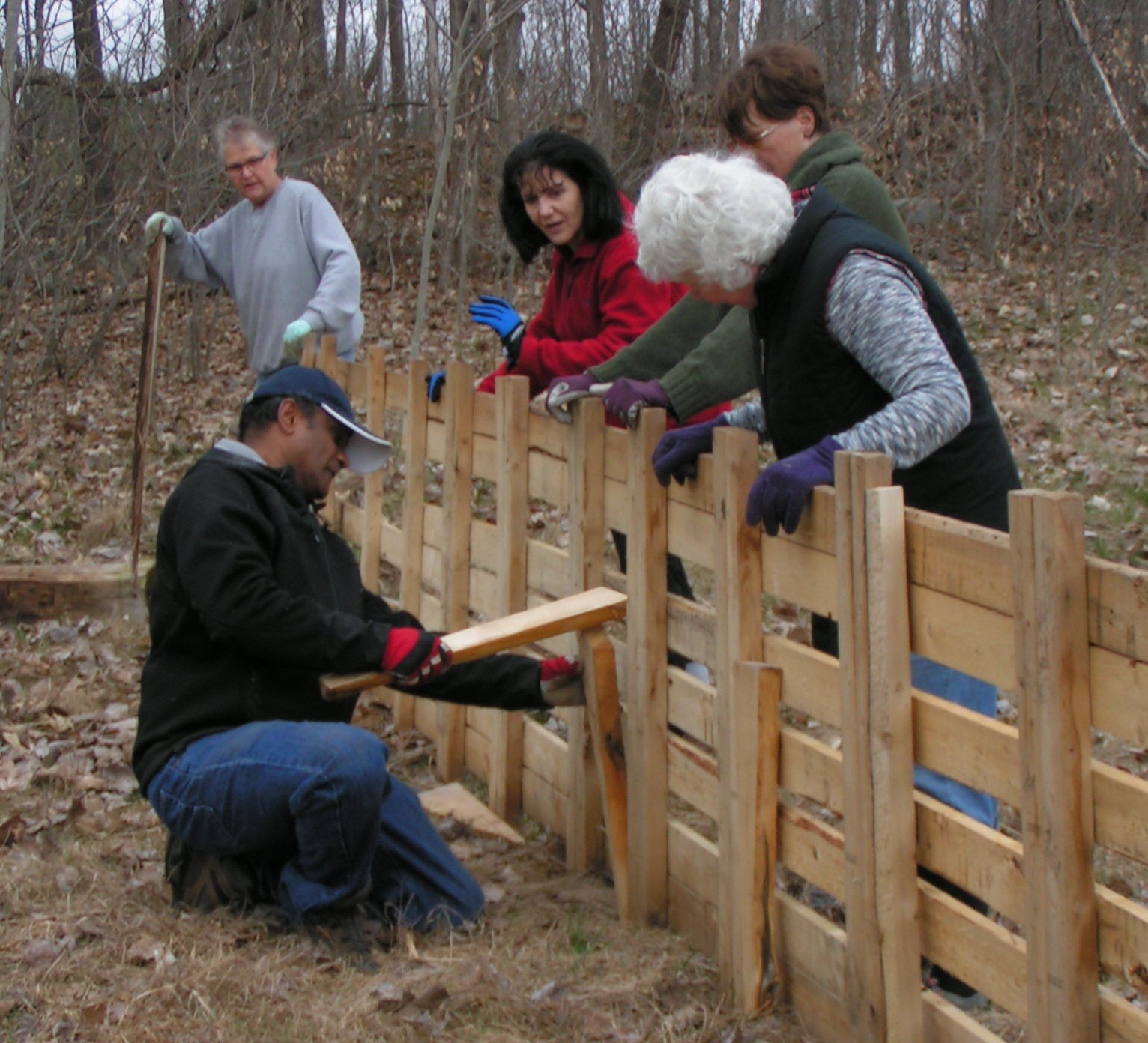 It was the last Sunday of April – cool, bright, brimming with birdsong and the sounds of the Hermitage woodland, and remarkably for early Spring, no black fly to be seen!
It was the last Sunday of April – cool, bright, brimming with birdsong and the sounds of the Hermitage woodland, and remarkably for early Spring, no black fly to be seen!
We gathered for a day of mindful work and practice, two dozen strong, unhurried, working in teams with our shovels, rakes, loppers, spades, wheel barrows as well as sparkling humour, joy and mindfulness. We moved sand, old logs, weeds and mulch – clearing the grounds for Spring flowers and clover seeds; pruning overgrowth from paths; and creating weed-free spaces around meditation cabins.
By morning’s end, we were glad to hear the sound of the meal gong. It was a bountiful feast – blessed, offered, and eaten in friendship and beauty – and a fitting preamble to our silent meditation in the Buddha Hall. We chanted and sat together, practising the Buddha’s teachings and reflecting on the strength of spiritual community.
Work, eat, meditate, praise the Blessed One, garner strength from each other and unfold the Noble Eightfold Path. What is one hundred per cent of the Path?
Wise and noble friendship.
Fusion of Faiths
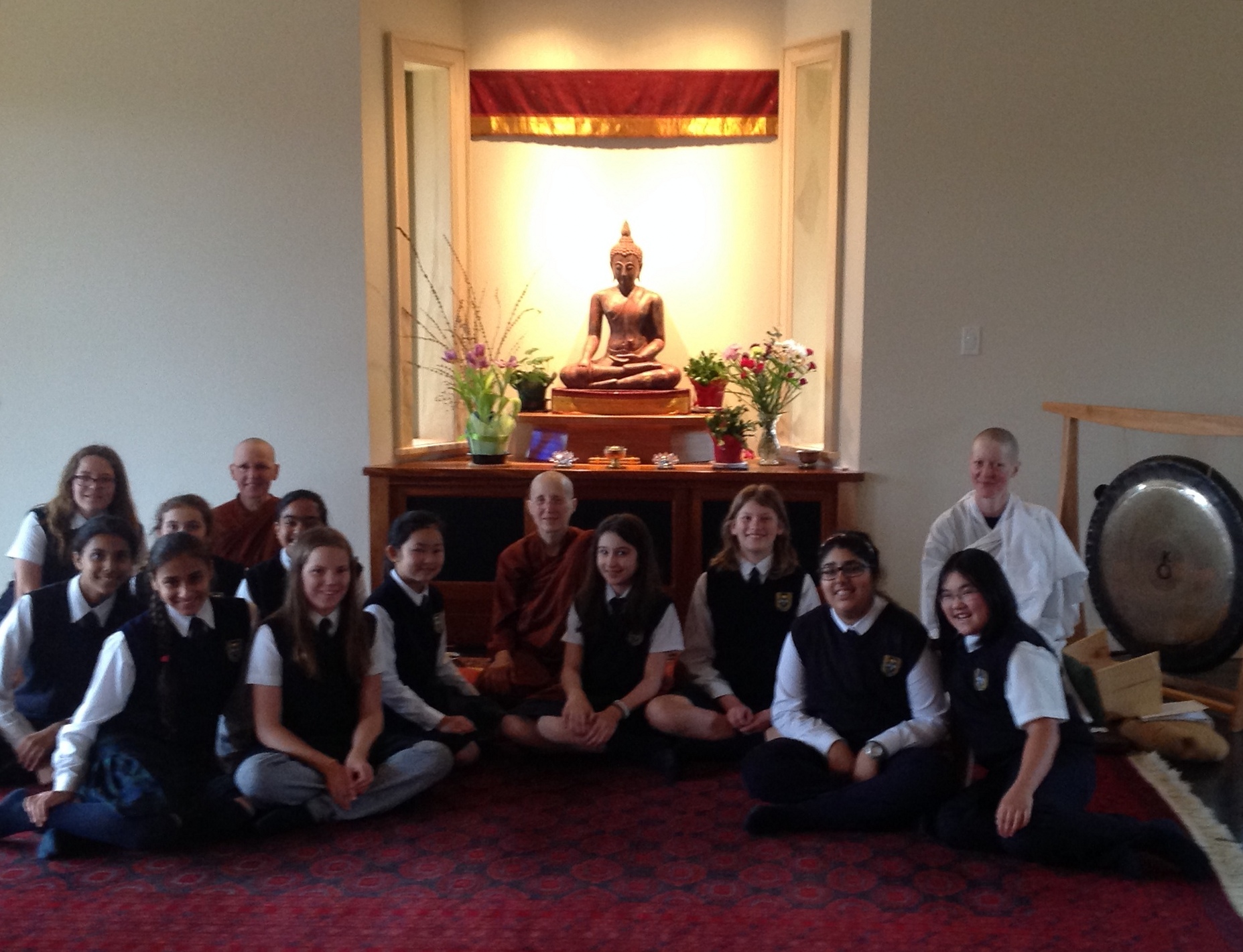 Students from the grade 6 religion class at Joan of Arc Academy experienced the Buddhism section of their studies live in a recent field trip to Sati Saraniya Hermitage. Our afternoon together included meditation time and a question/answer session about monastic life which touched on the common ground of our great spiritual traditions.
Students from the grade 6 religion class at Joan of Arc Academy experienced the Buddhism section of their studies live in a recent field trip to Sati Saraniya Hermitage. Our afternoon together included meditation time and a question/answer session about monastic life which touched on the common ground of our great spiritual traditions.
We chanted verses of blessing and protection to wish them well and, in turn, were showered with generous offerings of food items, flowers, soaps and other thoughtful gifts. Meeting this way in kindness, generosity, respect and openness was an opportunity for greater understanding and friendship, not to mention the joy and gratitude that flowed in both directions while rescuing their school bus when it got stuck in the mud!
Sanctuary
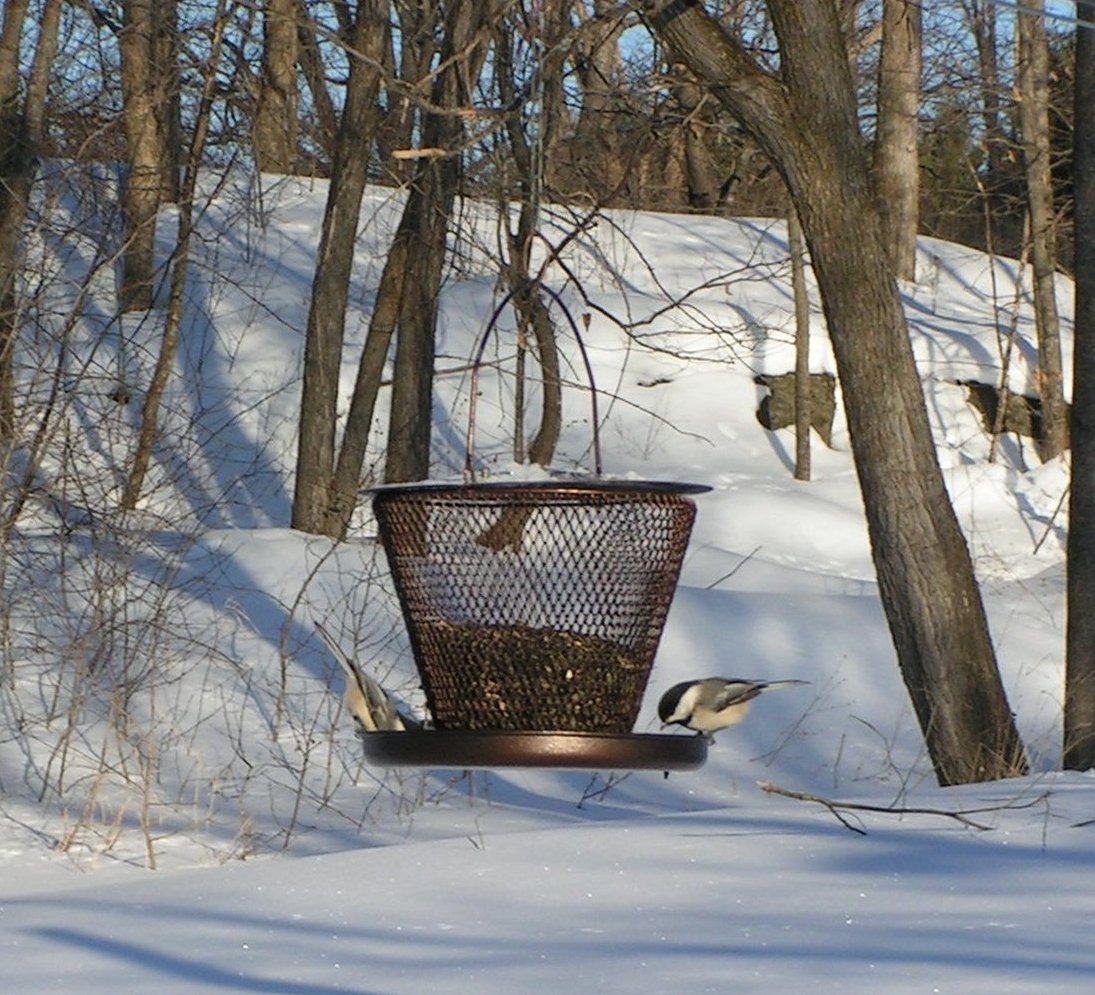
“Just as birds leave no tracks in the air,
there are those whose minds do not cling to what they receive,
their focus is the signless state of liberation
that to others is indiscernible.
Just like birds who leave no tracks in the air,
there are those whose minds are freed of greed and hate,
unconcerned about food or shelter
their focus is the signless state of liberation.
Like birds in the sky that leave no tracks,
they move unhindered on their way.”
Dhammapāda, 92-3 (adapted)
All winter long, on the darkest days, when shrill winds whip across the world and the earth is thick with snow and ice, these tiny winged friends appear. Time and again, they happily feed on what is given, taking their turns, and singing their thanks and praises.
As we venture into the unknown terrain of the heart, they teach us what is possible – even in harsh conditions. How blessed we are to undertake this interior pilgrimage, well-cared for by the kindness all around us, provided with alms food, warm clothing, shelter, medicines, and seclusion from worldly activities.
Yet, at times, we feel blinded and shaken by the relentless clout of craving or erratic mental weather, and the search for true refuge seems beyond our reach. In such precarious moments, how can we sustain our footing?
We look to the Buddha himself, a human being who, by his own example, taught us that we can know the signless, the Deathless, that unsurpassed freedom and peace of heart.
“Friends, it is through not understanding, not penetrating the Four Noble Truths that I as well as you have for a long time run on and gone round the cycle of birth-and-death. What are they? By not understanding the Noble Truth of Suffering, we have fared on, by not understanding the Noble Truth of the Origin of Suffering, of the Cessation of Suffering, and of the Path Leading to the Cessation of Suffering, we have fared on round the cycle of birth-and-death.”
“And by the understanding, the penetration of the same Noble Truth of Suffering, of the Origin of Suffering, of the Cessation of Suffering, and of the Path Leading to the Cessation of Suffering, the craving for becoming (sorrow’s root) has been cut off . . . the support of becoming has been destroyed, there is no more rebirth.”
Mahāparinibbbāna Sutta, Digha Nikāya 16 The Great Passing: The Buddha’s Last Days
Hearing his words, we carry on, guided by the Buddha’s map of consciousness. We calm the mind, summoning greater integrity, gratitude, and contentment to heal and protect it. Loving-kindness and compassion add radiance, joy and uplift while mindfulness serves as our trustworthy compass.
Should we stumble or lose heart, wise reflection helps us rekindle our resolve and trust enough for one more step, a new moment, another breath. We keep going – restored, nurtured, and single-minded – gently steering our way forth again to an ancient refrain of thanksgiving: “Namo tassa bhagavato arahato, sammāsambuddhassa.”*
We learn that sanctuary is here – letting be, going inward, sweeping away the cobwebs and detritus of lifetimes in search of that Dhamma jewel. And every morning the chickadees return, reminding us to persevere; whatever storm, whatever trial or obstacle, just to patiently endure and stay on course, as long as it takes.
Ayyā Medhānandī
*Pāli phrases meaning: Homage to the blessed, noble and perfectly Enlightened One
Ethical Footprint
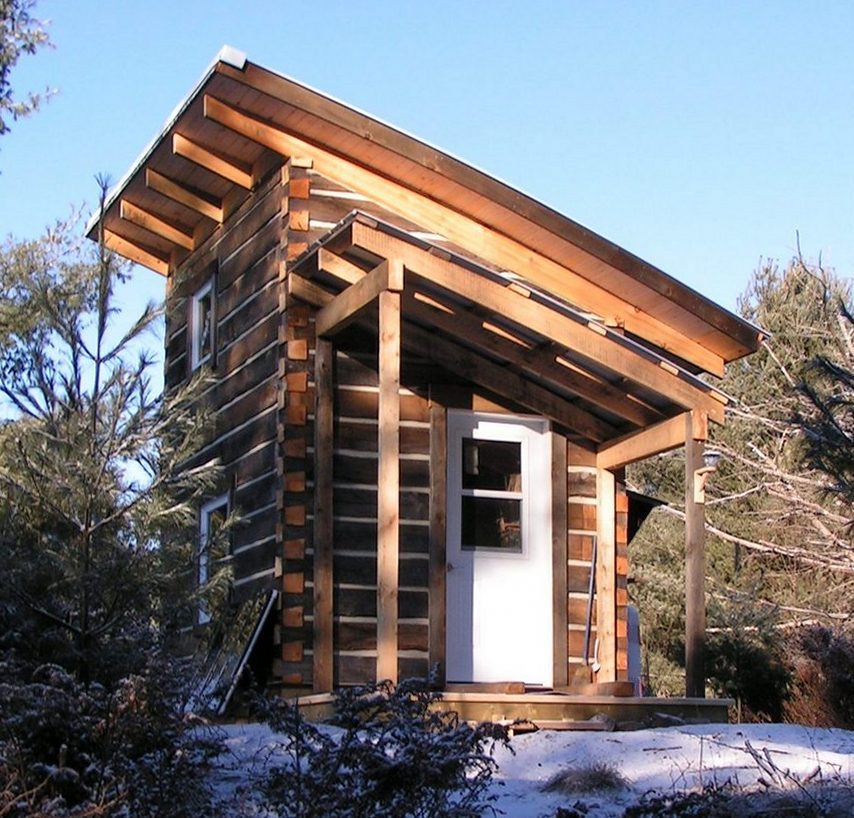 A prevailing theme of the Buddha’s own life and teachings resounds for his disciples across more than two and a half millenia. Repeatedly, he extols the virtues of dwelling in the wilderness, exhorting us to devote ourselves to solitude, seclusion, and meditation so that we can realize Nibbāna, the Deathless.
A prevailing theme of the Buddha’s own life and teachings resounds for his disciples across more than two and a half millenia. Repeatedly, he extols the virtues of dwelling in the wilderness, exhorting us to devote ourselves to solitude, seclusion, and meditation so that we can realize Nibbāna, the Deathless.
1. “Thus have I heard. On one occasion the Blessed One was living in the Kuru country where there was a town of the Kurus named Kammāsadhamma. There he addressed the bhikkhus thus: “Bhikkhus.”—“Venerable sir,” they replied. The Blessed One said this:
2. “Bhikkhus, this is the direct path for the purification of beings, for the surmounting of sorrow and lamentation, for the disappearance of pain and grief, for the attainment of the true way, for the realisation of Nibbāna—namely, the four foundations of mindfulness.
3. “What are the four? Here, bhikkhus, a bhikkhu abides contemplating the body as a body, ardent, fully aware, and mindful, having put away covetousness and grief for the world. He abides contemplating feelings as feelings, ardent, fully aware, and mindful, having put away covetousness and grief for the world. He abides contemplating mind as mind, ardent, fully aware, and mindful, having put away covetousness and grief for the world. He abides contemplating mind-objects as mind-objects, ardent, fully aware, and mindful, having put away covetousness and grief for the world.
4. “And how, bhikkhus, does a bhikkhu abide contemplating the body as a body? Here a bhikkhu, gone to the forest or to the root of a tree or to an empty hut, sits down; having folded his legs crosswise, set his body erect, and established mindfulness in front of him, ever mindful he breathes in, mindful he breathes out…”Majjhima Nikāya 10. Satipaṭṭhāna Sutta:
The Foundations of Mindfulness
Due to the extremes of Canada’s winters, and as bhikkhunis, we do not use the roots of trees as a resort, but we have empty huts. Thanks to the kind generosity of our community, this winter we have two log kutis* styled after the early settlers’ wooden log houses – apart from a smaller footprint of 108 square feet, metal roof and modern double-hung windows. The locally-grown pine logs are dovetailed in traditional fashion and built to last for generations of meditating monastics.
We are happy to be testing them during our winter retreat. They are superbly suited to forest-dwelling and contemplative practice. Though designed for sustainability and care of the earth, above all, inside these tiny spaces we are eager to reduce the kilesa* footprint in our minds.
*kuti: meditation hut
*kilesa: mental hindrance ie. greed, hatred, delusion, anxiety, restlessness, pride, selfishness…
Daughter of the Buddha
We were moved to witness this act of profound commitment to the holy life. For every one of us, it nourishes the aspiration for spiritual awakening and brightens our resolve to persevere on this path of prudent happiness.
Unexpected Blessings
After the solitude of our winter retreat and the return of bright spring days, we decided to follow the ancient Buddhist practice of walking for alms to receive spontaneous offerings of food from the community. On Saturday mornings, we have been going pindapat in the Perth Farmers’ Market. We stand between the colourful displays of fruits, plants and home-made products where vendors and passers-by exchange friendly greetings. Time and again, our alms bowls have been overflowing with generosity – a sign of the warm reception and interest people express in our way of life and local presence.
These last few weeks have also been a time of receiving new visitors to the Hermitage, notably Ayya Anandabodhi, co-founder of Aloka Vihara in California. Not only is she the first bhikkhuni we have hosted for an extended visit, but we also share more than 20 years of spiritual friendship as nuns. It was rich and meaningful for our community to have her with us and to hear her teach the Dhamma.
We also welcomed visits from several women interested in monastic training. One of them, Denise Morrison of Pennsylvania, presented us with a special gift – a portrait she painted of Arahant Mahapajapati Gotami, the Buddha’s aunt and surrogate mother. This life-like portrayal of our first elder bhikkhuni and ancestral mother is now framed and mounted in our vestibule.
One of our guests from the UK took a spiritual name, Acala (the Pali word for ‘unwavering’), and requested anagarika ordination – living as a homeless one. Her wish to formally receive the eight precepts, wear the white robes and have her head shaved by her 50th birthday will be fulfilled on Saturday, July 5, 2014, in the meditation hall at Sati Saraniya Hermitage.
Acala’s devotion to the teachings of the Buddha stirs us to reaffirm our own aspiration for awakening. We remember how rare and precious it is to live dependent on the kindness of others and to commit ourselves to truth, harmlessness, greater wisdom and compassion. When we reflect in this way, every day for us is filled with blessings. These act like a scaffold that sustains us through the many spiritual trials and hurdles that must be overcome. In turn, what we receive, we give back.
First Things First
Just as a deep lake is clear and still, even so, on hearing the teachings and realising them, the wise become exceedingly peaceful. Dhammapada 82
Every year has been auspicious for our community and 2013 was no exception. We will remember it as the year the Temple was completed, rising in the footprints of four ancient barns that stood sentinel for a century at the top of our driveway. And we remember the many inaugural events we hosted inside the meditation hall – a first day of gratitude to parents with the Tisarana Sangha, a first ordination ceremony, and a first residential retreat on the theme of ‘Death and Dying’.
We also remember the joy of our first mornings of pindapat along the rural lanes of Lanark County. Following the spirit of the Buddha going for alms in village India more than two and a half millenia ago, we walked mindfully in silence with our alms bowls to the homes of dear devotees to receive a meal offering and chant blessings.
During the last five months, the palpable stillness and beauty inside the meditation hall created a welcome haven for many overnight guests, stewards and local friends who joined us for evening and weekend practice sessions. For the first time, this year it will become sanctuary for our three month winter retreat.
By taking this time to stop and devote ourselves to meditation, we practise balancing the pace and demands of our commitments. Instead of focusing outwardly, we give ourselves to the vital work of looking within. Instead of singling out the ‘firsts’ of our past year, or of our life, and remembering them as special, we see and investigate our experience moment by moment.
We discover that every breath is its own ‘first’, a new beginning in which awareness grows clear and deeper truths are revealed. These are the seeds of peace and wisdom that stopping and studying our own hearts can foster.
May each of us remember to stop – no matter how compelling or important our activities, or how much enjoyment they bring. Devotion to the higher mind will yield a greater happiness, a deeper peace, and a viable refuge from the world.
May we all strive to purify our hearts and bring forth more loving-kindness and compassion in this world.
